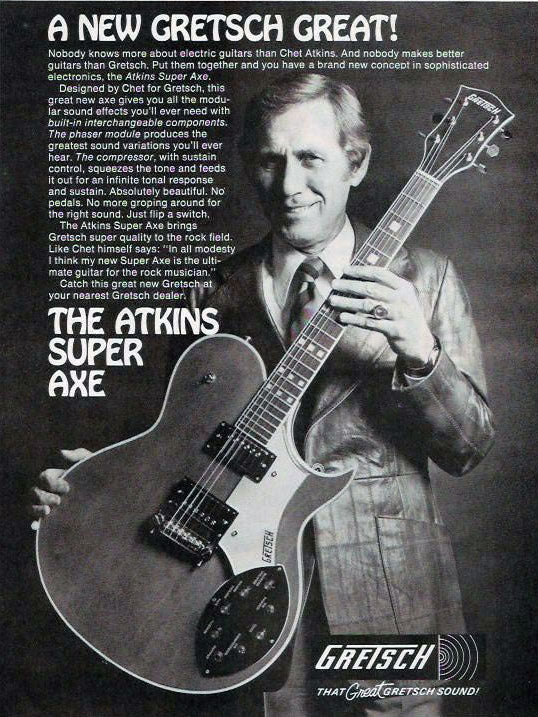AF110: The Gretsch Atkins Super Axe 1976-1980

Editor’s Note: Longtime readers of 20th Century Guitar will recognize the nom de plume G7 and his column “Anything For $1.10”. This infamous, hilarious, and enigmatic writer makes his return to writing about all things musical for themusiczoo.com. G7 will be a regular contributor to these pages and we are glad to have him.
The Gretsch Atkins Super Axe (1976-1980) by G7
How wacky is the guitar business? In the late 1970’s the Gibson guitar line had evolved into soulless ghosts barely echoing past greatness. Fender seemed equally befuddled. The Guild electric guitar division couldn’t find its ass with both hands and a flash light. So who came up with a hip new design that looks good, plays well and is even (Oh My God !) innovative? Gretsch!! Gretsch??? Weren’t they the company that spent the late 60’s and early 70’s undoing whatever good they had accomplished earlier? Weren’t they the company that specialized in guitar befuddlement? How did they do this? Well, basically they built a guitar identifiable as a Gretsch only by the name on the headstock.
The Super Axe and its plainer sister, the Axe were actually true solid body instruments unlike the semi-hollow guitars that had made Gretsch famous. They sported stud mounted wrap around bridges that Gretsch (ever the nomenclature kings) called Terminators but were actually Leo Quan Bad Ass units. Want that sweet Gretsch twang? Don’t look for it on the Axes. These babies sport factory DiMarzio humbuckers (huh?).
What about the famous Gretsch “kitchen sink” approach to bells and whistles? Think of the Viking with its mute and T-Zone and that scary floating tuning fork thing that made restringing pretty much impossible. Fear not. Although it has standard volume and tone controls, the Super Axe has a football shaped control plate that would make NASA proud. A trap door on the back of the guitar houses two 9 volt batteries that power the controls which consist of master volume, phaser on-off, phaser blend and rate, compressor on-off, sustain and master tone (phew!). All controls are labeled “upside down” so they can be read when the guitar is strapped on. The phaser and compressor effects are of unknown origin but sound like old MXR Phase 90 and Dynacomp tones. They actually work pretty well but can be bypassed if so desired.
Both axes were available in either a reddish orange finish Gretsch called Rosewood or a translucent gray color called Ebony Stain. The bodies had extra wide binding. Neck and headstocks were also bound. Fingerboards were ebony with unique small square fret markers and flat radii.
The Super Axe and Axe were perhaps designed with input from Chet Atkins as they have the familiar 24 ½” scale and zero fret. These instruments were in some ways harbingers of the instruments Gibson would produce in the 1990’s with him. Back then they may have been Chet’s idea for a (good) rock and roll guitar. It’s hard to envision his style of playing on one of these but we should assume nothing about his talents. In an era of disco and punk, the Super Axe was uniquely suited to both genres and more. Even though the Axe and Super Axe sold well they were discontinued by 1981. Ultimately it was yet another example of Gretsch’s ability to isolate a market then ignore it. G7





